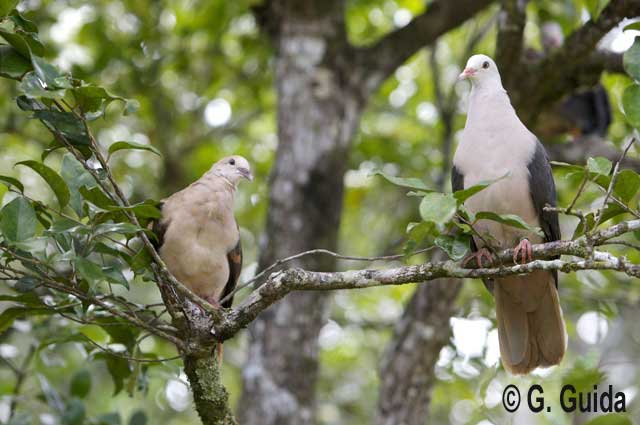
A pair of Pink Pigeons
|
| |
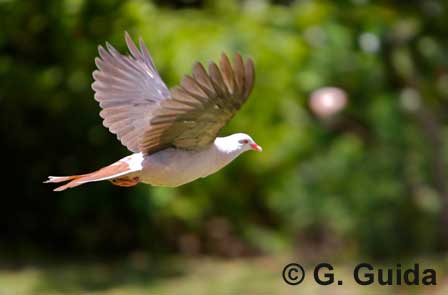
Pink Pigeon
in flight
|
| |
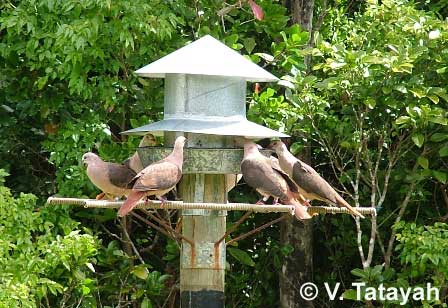
A feeding station
|
| |
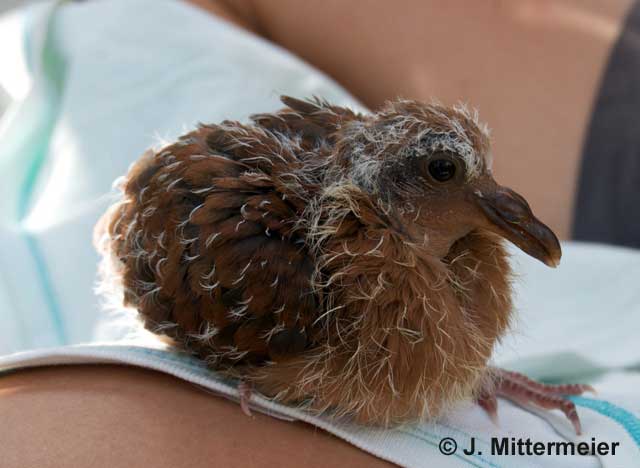 Pink Pigeon Pink Pigeon
squab
|
| |
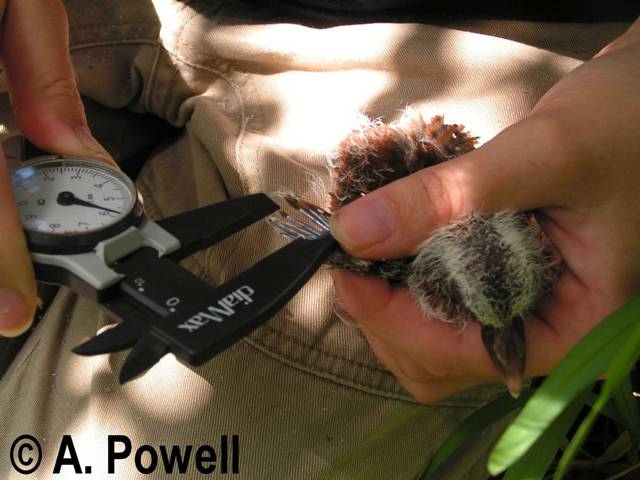
Collecting data
in the field
|
| |
| |
|
The Pink Pigeon was once widely distributed across Mauritius; sub-fossil remains from Mare aux Songes confirm that they were even found in the lowlands. By the 19th century, this distinctive pigeon was confined to the upland forest and its population had become heavily fragmented. The main factors in the decline of the Pink Pigeon are the destruction of native forest (primarily for sugar cane cultivation), hunting and the introduction of predators such as rats, mongoose, monkeys and feral cats. Pink Pigeons are also adversely affected by the degradation of the remaining forest by introduced plant species, primarily Chinese Guava Psidium cattleianum and the privet Ligustrum robustum var. walkeri, which invade and choke the forest, preventing the regeneration of native plants. By the 1950s the numbers had declined to around 50 individuals and by the mid-1970s this had fallen further still to a single population of 20 birds in the upland forest of the Black River Gorges near Bassin Blanc, now known as Pigeon Wood. Just 12 Pink Pigeons remained in 1986, and of the 5 nesting attempts recorded that year none were successful, following predation by rats. The chances of the long-term survival of the species looked bleak.
As a result of the severe population decline, MWF established an intensive conservation programme, with the initiation of captive breeding in 1976, followed by the first releases into the wild in 1987. We now have five sub-populations centred around our field stations and Conservation Management Areas (CMAs), all within the Black River Gorges National Park. Four of them are in the uplands: Brise Fer, Pigeon Wood, Bel Ombre and Combo, with a more recent one situated in the lowland area of the lower Black River Gorges. A sixth sub-population now exists and is thriving on the predator-free island and nature reserve of Ile aux Aigrettes. Additional sub-populations will be required in order to increase the wild population and to encourage the dispersal of birds between the different areas in order to maintain genetic diversity. In total we now have over 470 wild Pink Pigeons at these sites, a dramatic improvement from the 12 birds found in 1986.
In addition to captive breeding, the management of each sub-population is very intensive and entails the following management practices:
-
Monitoring - every Pink Pigeon is ringed with its own metal ID band and unique plastic colour combination. Each bird can therefore be identified and followed individually. All nests are checked regularly and the results documented. A large dataset has now been collected and continues to grow. This precise information can be used to enable us to understand in more depth the factors affecting the survival of the Pink Pigeon and to shape our management strategies accordingly.
Supplementary feeding - the degradation of the Pink Pigeon’s natural habitat is so advanced that the birds are very often not able to find enough food to support themselves. They are herbivores, with a diet consisting mainly of the fruit and leaves of both native and exotic tree species. Pink Pigeons also forage on the ground where they turn over leaf litter to pick up leaf fragments, pieces of grit, soil and fallen seeds. In order to supplement their diet, whole wheat is provided at each of the field sites. The food is placed in specially designed hoppers to exclude the majority of exotic birds from obtaining it. As a result, the pigeons are in better health and the feeding contributes towards more successful breeding throughout the year
-
Predator and disease management - predators are recognized as a major limiting factor to the survival of a species. We attempt to remove or lessen their impacts around field sites by using poison grids for rats and trapping grids for all three of the major predators: rats, cats and mongoose.
In the long term, large areas of forest will need to be restored so that the Pink Pigeon can spread out into the rest of the upland forest and breed in safe nesting sites, with fewer predators. For now, we are working on additional sub-populations with the introduction of a new sub-population at Pétrin, which hopefully will provide a link between two existing populations leading to breeding between them, increasing the genetic diversity. We are continuously seeking to improve our knowledge of the biology and ecology of the Pink Pigeon, measures contributing towards this include a PhD study researching the factors limiting the recovery of this species, and phenology studies examining the fruiting and flowering of specific plants that the pigeons feed on, which when studied alongside the feeding observation data that we collect will enable us to tailor our supplementary feeding more precisely. Ultimately all of these measures should enable us to meet our target of 600 wild-living Pink Pigeons.
More info: Downlisting the Pink Pigeon from Endangered to Vulnerable |
|